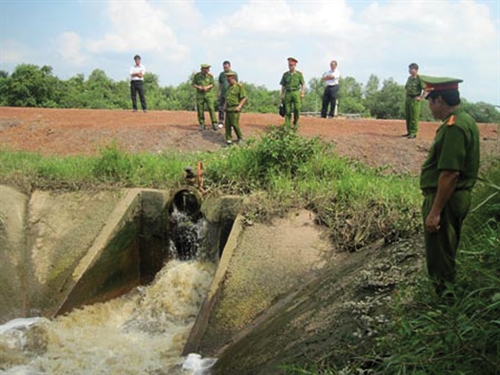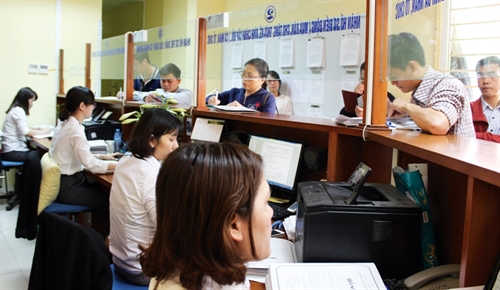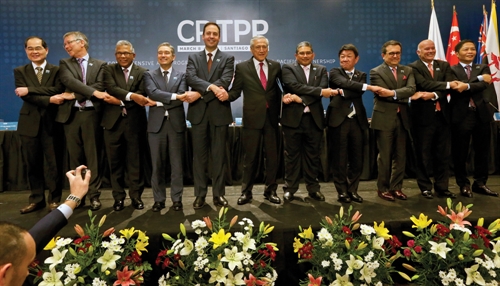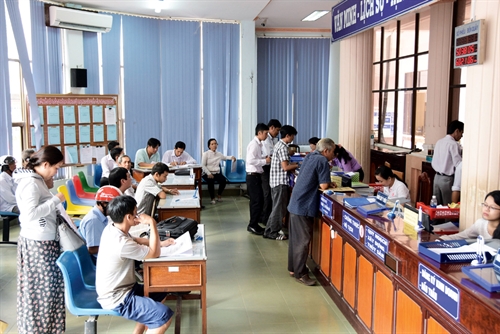This article presents a snapshot of key findings from the 2017 Vietnam Provincial Governance and Public Administration Performance Index (PAPI) research project.[1] The 2017 PAPI Report provides data and analysis about the country’s performance in governance and public administration, as drawn from citizens’ direct interactions and experiences with local governments at different levels in 2017. It captures experiences and perceptions related to the performance of local governments in governance and public administration based on a survey of 14,097 citizens with different demographic characteristics, randomly selected from all 63 provinces and centrally run cities.
Dang Hoang Giang, Edmund J. Malesky, Paul J. Schuler and Do Thanh Huyen[2]
Introduction
Nine years after the first pilot and seven years after the first nationwide implementation, PAPI has become an increasingly reliable and trusted source of data on how well local governments in Vietnam perform in the eyes of citizens. Based on more than 103,000 face-to-face interviews since 2009 with citizens randomly selected from all 63 provinces and centrally run cities (below referred to as provinces), PAPI has been useful in ushering in a new thinking about governing based on quantitative evidence. Top leaders from the Communist Party of Vietnam, the National Assembly and the Government have frequently referred to PAPI findings when engaging with individual provinces or sectors, using it as a valuable dashboard to guide and improve governance, with the ultimate goal to improve citizens’ satisfaction with public services. The media, mass organizations and non-governmental organizations have used the wealth of PAPI data to demand more accountability from the Government, and to inform their development and business strategies.
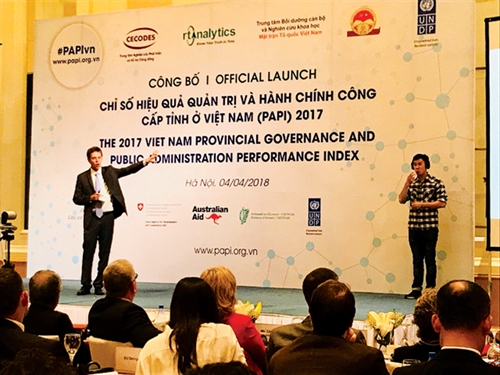 |
| The ceremony to launch the 2017 provincial governance and public administration performance index (PAPI 2017) on April 4__Photo: Internet |
Discussions are continuing in 2018 about how to achieve the goal of creating a “chính phủ kiến tạo” (facilitating government) against the backdrop of an unprecedented crackdown on mismanagement and corruption, such as the cases involving Ocean Bank and PetroVietnam (PVN). These efforts signal a new level of seriousness and commitment by the Government to fighting these lethal problems. New legislation, such as the Law on Access to Information, promises a better framework for transparency. In this context, PAPI continues to help the Party, the Government, and society at large to validate these crucial efforts and evaluate their effectiveness over time.
PAPI is a quantitative measurement tool that offers a comprehensive picture of how central and provincial governments have performed on an annual basis. PAPI provides data and evidence that reflect six dimensions of government performance: (i) participation in elections and policymaking at the local level, (ii) transparency in decision-making, (iii) vertical accountability, (iv) control of corruption in the public sector, (v) public administrative procedures, and (vi) public service delivery. By its theory of change, PAPI puts citizens at the heart of Vietnam’s development. As ‘end users’ of public administration and public services, citizens are fully capable of assessing the performance of the central and local authorities and of supporting the country in building a state “of the people, by the people and for the people.”
This article is to highlight the national trends and main findings from the 2017 PAPI Report, as well as implications for policy and practical actions to improve the performance in governance and public administration by national and provincial authorities.
National trends in governance and public administration in 2017
Positive trends in overall performance of governments in their second year of the 2016-2021 term
The 2017 PAPI findings, as shown in Figure 1, reveal positive overall trends worthy of note. There was improvement, although at different rates, in five of the six PAPI dimensions compared to 2016, in particular in the areas of Transparency, Vertical Accountability, Control of Corruption in the Public Sector, Public Administrative Procedures, and Public Service Delivery. In terms of citizen perspectives, different demographic groups perceived governance quality differently. Breakdowns of the PAPI dimensional scores by ethnicity and gender show that men and the Kinh majority held the most positive views across nearly all dimensions in 2017. The only dimension where gender and ethnicity did not matter greatly was Public Service Delivery. (see Figure 1)
 |
 |
More optimism about government performance in control of corruption in the public sector
Of all six dimensions, the dimension Control of Corruption in the Public Sector improved the most, with both perceptions and actual experiences exhibiting improvement. For instance, the percentage of citizens directly experiencing bribery when applying for land use rights certificates fell from 23 percent in 2016 to 17 percent in 2017. Another positive sign is that the rate of bribery experienced when using public district hospital services decreased from 17 percent in 2016 to 9 percent in 2017. However, tolerance of bribes slightly increased, with citizens indicating that an average bribe amount of VND 27.5 million would trigger the victim of corruption to denunciate the person requesting the bribe in 2017, compared to an average of VND 25.6 million in 2016. While these generally good results are welcome, it is important to note that they did not reach the levels of satisfaction found in 2012. Therefore, work remains on fighting corruption.
Narrower gender gap in land use titling
One important area of concern related to land is gender inequality in land use titling. The 2017 results show a narrowing of the gender gap: while 18 percent fewer women in rural areas reported having their names on land use certificates in 2016 compared to men, the difference fell by half to 9 percent in 2017.
Mixed feelings about land seizure and compensation
PAPI surveys have shown a substantial drop in the number of respondents reporting land seizures in their localities after the 2013 Land Law came into effect in 2014. The trend continued in 2017 with less than 7 percent reporting land seized, down from an average of about 9 percent prior to 2013. Nonetheless, a more concerning trend is that the level of satisfaction with compensation for land seizures declined in 2017. While 36 percent thought the compensation was at a fair market value in 2014, the percentage dropped to 21 percent in 2017.
Better and more inclusive health insurance coverage
The number of citizens with health insurance continued to increase, rising from 74 percent in 2016 to 81 percent in 2017. Further analysis shows that the strongest gains were made in rural population groups. In 2014, only 60 percent of rural residents had health insurance compared to 69 percent for urban residents. That gap narrowed in 2017 to less than 4 percent.
Increased pessimism about house-hold economic conditions in the future
When asked about expectations of household economic conditions in the next five years, the survey results show a steady increase since 2014 in the number of citizens who think their household economic situation will worsen in the future. The increased pessimism is greater among the poorest Vietnamese. While only 13 percent of the Vietnamese with the lowest level of income in 2016 thought their economic situation would get worse, the percentage increased sharply to 21 percent in 2017.
Implications
Among areas of significant progress and disappointment that have policy and practice implications for central and local governments, the most important finding is the overall improvement in perceptions and experiences with provincial performance in control of corruption. Reversing a worrying trend since 2013, citizens provided more positive feedback on almost every indicator composing the dimension Control of Corruption in the Public Sector in 2017. This may reflect the recent crackdown on corruption at the national level, resulting in better control of corruption by local governments. It may also be attributed to the large media coverage of such efforts, giving some hope to citizens. Although the scores are still not better than in 2011 and 2012, the reversal of the downward trend since 2013 is both noteworthy and welcome.
On the other hand, in terms of overall satisfaction with governance and public administration, women and ethnic minorities tended to give lower scores compared to ethnic majority Kinh and males in five out of six dimensions, with the exception of the dimension Public Service Delivery. This points to an issue with policy and practice implications for Vietnam, especially as the country is implementing its national agenda toward more inclusive sustainable development by 2030.
Issues of great concerns in 2017 from citizens’ perspectives
This section looks more in-depth into issues important to Vietnamese citizens and the Government. In 2017, the most important issue in the minds of Vietnamese citizens was poverty reduction. Environmental protection, while not as important as in 2016, was still an important issue as well. Figure 2 presents the findings from the 2017 PAPI survey. (see Figure 2)
 |
 |
Poverty - the most important issue
For three consecutive years (2015-2017), the issue of the greatest concern for citizens has been poverty. In 2017, 28 percent of respondents cited it as a top concern, an increase of 4 percent compared to 2016. Two prominent findings emerge from the analysis regarding why so many citizens demanded that the State address poverty. First, poor citizens were concerned about falling back into poverty. Importantly, in poor areas of the country, even wealthier citizens expressed concern that their relatives might suffer. However, more important than personal anxiety was the concern among many about the impact of poverty on the country’s overall development. The most common answer from the survey was that poverty reduction is imperative to ensuring that Vietnam becomes an advanced, developed country.
High concern about the environment
The environment was the second most important issue to citizens in 2016, but dropped to the fourth issue of greatest concern in 2017; 7 percent of respondents cited it as the most important issue, a drop by 5 percent compared to 2016. Additional analysis was conducted to assess the degree to which Vietnamese citizens prioritized environmental concerns when they come into conflict with economic concerns. Results show a strong intolerance for projects and policies that would damage the environment. With regard to investment projects, citizens overwhelmingly said they would not welcome investments that might generate jobs if those projects would damage the environment. Similarly, citizens also were more concerned about the potential environmental impact of coal-fired power plants than they valued the benefits from reducing power outages. This suggests that despite concerns about poverty, Vietnamese citizens are not willing to risk environmental damage for more economic growth.
Limited awareness of the Law on Access to Information and use of e-government portals
The PAPI survey has tracked citizen awareness of the Law on Access to Information and the use of e-government portals over the past few years. These issues are important given the recent passage of the law and the continued investments in e-governance at the local level. In general, the findings show very little awareness of the law and limited use of e-governance portals. With regard to accessing information, citizens continue to rely on personal networks. Furthermore, the use of e-governance platforms is heavily related to education level and Internet coverage. With that said, this does not mean that such investments are wasted. As education levels and Internet access increase, these portals may become increasingly valuable.
Implications
This section reveals important policy issues in Vietnam: poverty reduction, environmental protection, and e-governance. The overarching takeaway is that Vietnam’s increasing economic development creates more complicated and demanding governance challenges and opportunities. Many Vietnamese citizens, particularly the poor and those living in poorer provinces, were worried about either themselves or family members falling into poverty. However, the most consistent concern is that poverty is a drag on Vietnam’s overall development. In particular, poverty deprives the country of a well-developed education system capable of training the next generation of workers.
At the same time, the analysis of environmental concerns shows that Vietnamese citizens are not willing to pursue economic development at any cost. Vietnamese citizens, particularly educated ones, show remarkable concern for the environment, even when there are economic trade-offs. This suggests a difficult juggling act for the government: how to continue providing economic opportunities for all while remaining sensitive to environmental externalities of economic development.
Findings presented in this section also show that the use of government portals by citizens so far has been minimal. Further analysis suggests that while this should lead to concern, there are reasons to be optimistic. In particular, more educated citizens and those with Internet access are more likely to use these portals. As citizens increasingly gain in education and Internet connectivity, uptake may eventually increase. This suggests that the Government should do more to enhance the usefulness and user-friendliness of the online tools, including downloadable forms, and, more importantly, greater efforts should go into increasing access to detailed information about processes and procedures that citizens need.
Provincial performance in 2017
Trends in provincial performance
Overall, as Table 1 reveals, none of the 63 provinces excelled in all six PAPI dimensions in 2017. Quang Binh, Ben Tre and Bac Lieu were in the best performing groups in five out of the six dimensions, though Bac Lieu remained in the low average performing group in the Vertical Accountability dimension. There also was a trend of converging provincial performance, as seen from the lowest and highest aggregate provincial scores in 2017 compared to the previous years.
Still, as shown in Figure 3, the gap in 2017 between provinces receiving the highest and the lowest scores (33.09 points) remains significant. And there is a significant disparity between the highest provincial score (39.52 points) and the potential maximum score of 60 points (on the scale of 10-60 points for all six dimensions). These findings indicate that provincial governments need to do more to satisfy their citizens’ expectations. (see Figure 3)
 |
 |
When comparing 2017 results with the 2012 results - both the second year of five-year government terms (2011-2016 and 2016-2021) - An Giang and Tra Vinh made significant progress in all three dimensions that were unchanged (Transparency in Local Decision-Making, Control of Corruption in the Public Sector and Public Service Delivery), with impressive increases of more than 10 points in each.
In terms of year-on-year changes (2017 against 2016) at the provincial level, none of the 63 provinces had significant declines, while seven provinces saw large improvements. Bac Lieu, Quang Ninh and Tra Vinh had the largest year-on-year increases (above 8 percent). When comparing 2016 and 2017 aggregate scores for the best performing group, 11 provinces (Bac Ninh, Hai Duong, Thai Binh, Nam Dinh, Ninh Binh, Ha Tinh, Quang Binh, Quang Tri, Binh Dinh, Ben Tre and Can Tho) maintained their status in this group. Meanwhile, Bac Giang, Phu Tho, Da Nang and Dong Thap fell back to the high average group, and Hung Yen fell into the low average group.
Highlights of provincial performance changes by dimension, 2016 to 2017
Citizen participation at local levels. Thirteen provinces achieved significant improvements while 14 saw significant declines from their 2016 performance levels. Hau Giang, Dien Bien and Dak Lak need to do more to improve their performance in engaging citizens at the local level. Amidst the progress made at the provincial level was a significant increase in the proportion of citizens reporting that local projects are monitored by citizen-led Community Investment Supervision Boards (up from 21 percent in 2016 to 34 percent in 2017). However, fewer contributors to the projects had opportunities to provide comments in local project design (the rate fell from 36 percent in 2016 to 33 percent in 2017).
Transparency in local decision-making. Fifteen provinces significantly improved their performance levels compared to 2016, with Bac Lieu, Quang Ninh and Ba Ria-Vung Tau seeing the largest increases in their scores. Meanwhile, 11 provinces (in particular Quang Ngai and Tien Giang) saw significant declines. Overall, however, the progress in this dimension was insignificant, with the greatest increase seen in the proportion of citizens confirming that commune budgets and expenditures were made publicly available (up from 32 percent in 2016 to 36 percent in 2017). A key shortcoming that remains is transparency of land planning, with only around 4 percent of citizens reporting that they had opportunities to provide comments on local land plans in both 2016 and 2017.
Vertical accountability toward citizens. Twenty-seven provinces made significant improvements, with the most impressive being Thai Binh, Vinh Long and Dong Nai; each increased their year-on-year score by more than 15 percent. On the contrary, 18 provinces saw significant declines, with the dimensional scores for Da Nang and Dak Nong declining by 15 percent compared to 2016. Overall, there was a slight increase in the proportions of citizens interacting with local authorities when facing any issue (for instance, 17 percent met with a commune government official in 2017, up from 14 percent in 2016). Nonetheless, fewer were satisfied with the outcomes of these meetings with commune officials (reported satisfaction fell from 83 percent in 2016 to 81 percent in 2017).
Control of corruption in the public sector. Over half of all provinces (33) saw a significant year-on-year improvement in this dimension. Quang Ninh, Bac Lieu, Ba Ria-Vung Tau, Lao Cai and An Giang received the greatest acknowledgement by their citizens for their improved efforts to control corruption in the public sector in 2017, with their scores rising by 20 percent or more from the prior year. Among the six provinces that saw significant declines are Dak Nong, Hung Yen and Hai Phong, with their scores dropping by 9 percent or more. Overall, there were lower rates of citizens saying that bribery was taking place in their provinces. However, among those that paid bribes across the country, only about 3 percent of the victims said they would denunciate the bribe requests in 2017, the same level as in 2016. (see Table 1)
Table 1: Summary of year-on-year provincial progress and setbacks (2017 against 2016) | |||||||||||||||||||||||||
| |||||||||||||||||||||||||
| Dimensions | Progress (≥+5 percent increase in point estimates) | Setbacks (≤-5 percent decrease in point estimates) | |||||||||||||||||||||||
| 1. Participation at Local Levels | • 13 provinces had significant improvements • Quang Ninh, Bac Lieu, Tra Vinh and An Giang saw larger increases (above 15 percent) | • 14 provinces had significant declines • Hau Giang, Dien Bien and Dak Lak saw larger declines (greater than -10 percent) | |||||||||||||||||||||||
| 2. Transparency in Local Decision-making | • 15 provinces had significant improvements • Bac Lieu, Quang Ninh and Ba Ria-Vung Tau saw larger increases (above 15 percent) | • 11 provinces had significant declines Quang Ngai and Tien Giang saw larger declines (greater than -10 percent) | |||||||||||||||||||||||
| 3.Vertical Accountability | • 27 provinces had significant improvements • Thai Binh, Vinh Long, Dong Nai, Cao Bang, Thanh Hoa, Hau Giang and Bac Giang saw larger increases (above 15 percent) | • 18 provinces had significant declines • Da Nang and Dak Nong saw larger declines (greater than -15 percent) | |||||||||||||||||||||||
| 4. Control of Corruption in the Public Sector | • 33 provinces had significant improvements • Quang Ninh, Bac Lieu, Ba Ria-Vung Tau, Lao Cai and An Giang saw larger increases (above 20 percent) | • 6 provinces had significant drawbacks • Dak Nong, Hung Yen and Hai Phong saw larger declines (greater than -9 percent) | |||||||||||||||||||||||
| 5. Public Administrative Procedures | • 8 provinces had significant improvement • Bac Lieu and Binh Phuoc saw larger increases (above 7 percent) | • 3 provinces had significant drawbacks • Can Tho, Bac Kan and Ha Tinh saw significant declines (greater than -5 percent) | |||||||||||||||||||||||
| 6. Public Service Delivery | • 8 provinces had significant improvements • Vinh Long and Quang Tri saw larger increases (above 7 percent) | • 2 provinces had significant setbacks • Binh Duong and Da Nang saw significant declines (greater than -5 percent) | |||||||||||||||||||||||
| Aggregated PAPI (unweighted) | • 7 provinces had significant improvements • Bac Lieu, Quang Ninh and Tra Vinh saw significant increases (above 8 percent) | • None of the 63 provinces had significant declines | |||||||||||||||||||||||
Public administrative procedures. As in previous years, the change in provincial performance in this area year-on-year was insignificant. Eight provinces saw an increase in their score by more than 5 percent, including Bac Lieu and Binh Phuoc which saw rises of 7 percent or more. Can Tho, Bac Kan and Ha Tinh were the three provinces that had significant declines. Overall, citizens seemed to be more satisfied with administrative procedures at local one-stop shops in three out of the four services that PAPI measures (certification, construction permits, and personal documents). For services related to land use rights certificates, however, there remains room for improvement; there was a slight decrease in the total quality of the services for land use rights certificates (down from 2.64 points in 2016 to 2.55 points in 2017 on the scale of 0-4 points).
Public service delivery. Changes in this dimension have been gradual, though Vinh Long and Quang Tri were among eight provinces with improvements greater than 5 percent. Interestingly, Binh Duong and Da Nang are the only two provinces with decreases in dimensional scores of more than 5 percent compared to 2016. Overall, there was a slight increase in the total quality of public primary schools and an insignificant decrease in the total quality of district public hospitals in all provinces over the two years of 2016 and 2017. Both indicators show a large gap between the current status of provinces in these areas and expected maximum scores, implying that both sectors need to do more to satisfy citizens.
Implications
This section presents overall dimensional and sub-dimensional findings on provincial performance in 2017 in a comparative perspective within and between provinces and over time. With the aggregate scores, provinces can assess how they have progressed over time, and how they compare with other provinces of similar socio-economic and geographical characteristics. It is important to reiterate that, as an aggregate index, PAPI serves as a “first cut” of a province’s performance in a certain year in a comprehensive manner, much like a primary care physician providing an overview to her/his client of her/his health. To understand what they can do to improve the performance of their province, provincial leaders are advised to examine findings for each indicator of the PAPI dimensions and sub-dimensions provided in the respective provincial profiles.
Also, findings in this section reveal key areas of progress as well as setbacks in the first two years of the current government term by comparing 2017 with 2016 indicators and changes over time since 2011. The results suggest areas where central and local governments should do more to improve their performance in governance and public administration. Furthermore, the indicators provided in PAPI help Vietnam review its performance related to implementation of the National Sustainable Development Goals (SDGs) by 2030.
Final remarks
PAPI has had a large impact, inspiring the continuation of this important project. To date, almost every province has hosted or convened a PAPI diagnostic workshop. Of the nation’s 63 provinces, 51 have issued action plans, directives, official letters and/or resolutions to request that local government agencies respond to citizen feedback through PAPI. In 2017 alone, 16 of these 51 provinces issued new or renewed provincial responses with a one- or three-year perspective, aiming at attaining higher citizen satisfaction with their performance. PAPI is expected to serve as a means of verification for better governance and public administration at the local level, while also informing the policy cycle for the central level in Vietnam.
But, many challenges lie ahead for PAPI. How can it be relevant to Vietnam’s changing reality after almost a decade since it began? How can we lever the aggregation of citizens’ voices for more effective changes to the performance of local governments in governance and public administration? We hope PAPI will provide data and evidence for ongoing and future discussions on how to translate policies into reality and how to make policies more grounded to satisfy citizens at large. With its connotation of ‘connecting the dots,’ the 2017 PAPI Report will help further bridge policy and practice, connect different government levels through better coordination and oversight, enhance the link between supply and demand for public services, and meet the expectations for sustainable development within and beyond Vietnam. We also hope for continued support and constructive feedback to make PAPI even more meaningful.-


